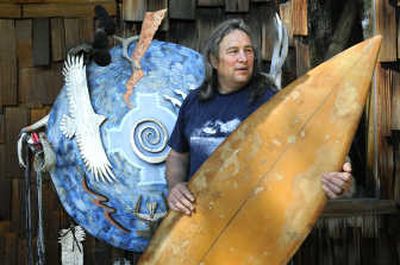Metal artist creates pieces of history

Most people know him simply as “that guy who did the runners at City Hall” or maybe “the guy who did those horses out by Vantage.”
Few could pick him out of a lineup.
Not that it really matters to Washington metal artist David Govedare.
People remember his iconic work, and that’s what matters to him. He has created some of the best-known public art in this part of the world: the feathers at the entrance to Coeur d’Alene, the Antoine Plante statue at Plantes Ferry Park and, of course, the Bloomsday runners and the ponies on the hill outside Vantage.
“Sometimes people see your art, but they think you just left for the mountains,” said Govedare, sitting on the deck outside his home in the forest by Chewelah, Wash. “As a public artist I would say that I like to tickle people’s wonderment. And I like doing historical work that somehow rights an injustice – I really enjoy that.”
In his sketchpad now are a towering monument, a tornado built of horses swirling upward, reaching for the sky.
“We’re hoping to do this together with the Coeur d’Alene Tribe, just outside Coeur d’Alene by the river, to commemorate all the horses that were murdered there,” said Govedare. One metal horse head is already done, its mouth open, nostrils flaring, resting in an old vise on the grass in front of Govedare’s house.
Grand Coulee artist Keith Powell has been a partner in some of Govedare’s projects, including this one. “I really hope we can pull this one off,” Govedare said.
With his strong profile, high cheekbones and long graying hair, many believe Goverdare is American Indian. He’s not.
“I’m a direct descendant of George Washington, no kidding,” he said, explaining that his family is German, Yugoslavian and Irish-English. “And my grandmother said I had some Cherokee in me, but all grandmothers say that.”
The son of an Air Force dad and a homemaker mom, he grew up in Texas and in Southern California, where he surfer. Now 57, he was young during the protest and uproar of the late ‘60s.
“One time, I came back from surfing and I really wanted a falafel, but the bank was being burned down by protesters, and I was like, whoa,” Govedare said. “Soon I found myself running down the street with my falafel. It was a culinary and political adventure all at once.”
He studied architecture at California Polytechnic State University at San Luis Obispo; in the summers he went to Montana, where he worked hauling hay.
That’s how he found Spokane, and after graduation, he moved here in time to work at Expo ‘74.
“For me, moving to Spokane at the time was like going to the Yukon way back when, in the old days,” Govedare said. He worked in architecture and design, bought a house and lived in Spokane for the next 12 years.
Yet it was working in the shop, not at the drawing board, that held his interest.
He learned to weld from his dad, and haunted local junkyards, looking for stuff to put together in figures and sculptures.
In 1975 he began sculpting full time.
“I did a lot of little things, and I took it all to the street fairs and small art shows in Portland, Seattle and California. I barely survived,” Govedare said.
The first sculpture he built in his current shop was the “The Joy of Running Together,” aka the Bloomsday runners, in 1985.
His house is surrounded by his sculptures and filled to the brim with cards and photos, figurines of animals, found feathers, rocks, dreamcatchers – one strategically located above his computer – books, drawings and photos. It began as a traditional cabin, but it’s been growing a Mexican-style, adobe straw bale addition to the back, a small greenhouse to the front and a more traditional garage to the other side.
“When I worked in Montana I swore I’d never touch another hay bale, and here I am, building a house out of them,” Govedare said. He grows a huge garden in the summer, below where his horses graze.
Rain Cloud, Eclipse and Pahto rumble a low nickering greeting when they see him.
Govedare has ridden them all over Yellowstone National Park and the Continental Divide, he said, but they are getting old and he worries about their health.
Govedare was at home there, with the horses around him, the trees above him and the creek babbling just over the little hill.
He talked about sustainability; his goal is to be able to make it on his own, on his little plot of land.
He has no traditional arts education whatsoever.
“I never thought much about knowing all the other painters and all that,” Govedare said. “I mean, how many plumbers know the names of all the other plumbers? That’s really how I see it.”
If you go
David Govedare’s artwork will be displayed in a rare gallery show at Escent Lighting Gallery, 605 W. Spokane Falls Boulevard, as part of today’s First Friday arts celebration. He’ll show free-standing aluminum sculptures with glass accent pieces.